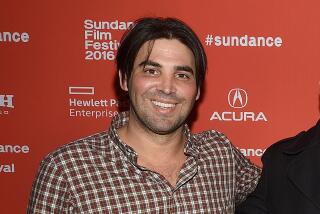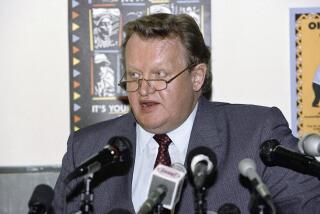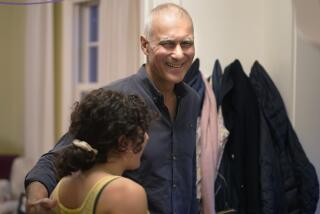Paul Lauterbur, 77; ‘the father of MRI’
Physicist Paul C. Lauterbur, who received a 2003 Nobel Prize in Physiology or Medicine for giving physicians the ability to look inside the human body without using harmful radiation, died Tuesday at his home in Urbana, Ill.
He was 77 and had been suffering from kidney disease.
FOR THE RECORD:
Lauterbur obituary: The obituary of Nobel laureate Paul C. Lauterbur in Wednesday’s California section identified him as a physicist. He was a chemist. —
Lauterbur played a key role in the development of magnetic resonance imaging, or MRI, which produces highly detailed images of soft tissues and organs without using X-rays.
Although the first MRI instruments did not become available until the early 1980s, their use has exploded to the point that more than 60 million MRI examinations are performed every year.
The technique is particularly valuable for imaging the brain and spinal cord, monitoring the progress of diseases such as multiple sclerosis and assessing damage to knees and other joints.
“Paul’s influence is felt around the world every day, every time an MRI saves the life of a daughter or a son, a mother or a father,” Richard Herman, chancellor of the University of Illinois at Urbana-Champaign, where Lauterbur was a professor, said in a statement. “He will be greatly missed.”
MRI relies on the magnetic properties of the hydrogen in water, which accounts for about two-thirds of the human body. When the hydrogen atoms are placed in a powerful magnetic field and bombarded with radio waves, they emit radio signals that provide information about their local environment.
Before Lauterbur’s work at the State University of New York at Stony Brook, chemists used this technique, called nuclear magnetic resonance, to help determine the structure of organic molecules. But nobody thought of using it for imaging because they didn’t know how it could be done.
Lauterbur’s inspiration — conceived at a restaurant table and sketched out on a napkin — was to establish a gradient in the field, varying its intensity at different points in the sample. That made it possible to determine where each atom was in relation to the others.
His thought processes were unique, said Caltech chemist John D. Baldeschwieler. “For years, everyone in the field was trying to get the most homogeneous field in order to get the highest possible resolution,” he said. “Lauterbur thought about the problem in a completely inverse way. If you didn’t have a homogeneous field, but a gradient, then the frequency would indicate position in space.”
Assembling his apparatus, he placed a test tube inside it and startled his colleagues with a faint picture. His first living subject was a clam taken from the nearby Long Island Sound.
In his original publication in the journal Nature, he called the new technique zeugmatography — from the Greek zeugma, or yoke — because it yoked together two different types of radiation, magnetic and radiofrequency.
Fortunately, that name did not last. Marketers also removed the “nuclear” from the name for fear it would invoke images of lethal radiation.
British physicist Sir Peter Mansfield of the University of Nottingham, who shared the 2003 Nobel Prize with Lauterbur, devised techniques for sequentially altering the magnetic gradient so the device could produce an image of a two-dimensional slice of the human body. He also perfected techniques to speed up the process, cutting the required time for producing an image from hours to seconds.
Lauterbur’s university decided not to file patent applications based on his work. “The company that was in charge of such applications decided that it would not repay the expense of getting a patent,” Lauterbur said in 2003. “That turned out not to be a spectacularly good decision.”
The University of Nottingham did file patents, however, and Mansfield became wealthy enough to donate a new MRI center to the university.
Lauterbur tried for years to get the federal government, particularly the National Institutes of Health, to fund a prototype of the instrument to image people, Baldeschwieler said. “It was an extraordinarily bold step. Nobody thought such a thing would be possible,” he said.
It took Lauterbur nearly a decade to get the funds and complete the instrument.
Once the technique was perfected, Lauterbur traveled around the world tirelessly promoting its advantages, said medical physicist Paul Bottomley of Johns Hopkins University. “It was an orphan technology, not in the mainstream of physics or chemistry, and not in mainstream radiology either,” he said. “Radiologists thought MRI could never replace computed tomography” until Lauterbur convinced them otherwise.
Meanwhile, he kept at work in his laboratory, inventing a variety of refinements, including MRI contrast agents and techniques to use it to obtain chemical information from specific sites in the body.
“He was really the father of MRI,” Bottomley said.
MRI has been so successful that the original technique has spawned numerous offspring. Functional MRI, for example, measures brain activity by detecting oxygen levels in specific areas. Diffusion MRI can detect strokes by measuring the movement of water across microscopic distances in the brain. MRI angiography diagnoses heart disorders by taking pictures of blood vessels.
Paul Christian Lauterbur was born May 6, 1929, in Sidney, Ohio. His earliest inspirations, he said, were his aunt Anna Lauterbur, who gave him a subscription to Natural History magazine and fed his interest in the world around him, and a high school chemistry teacher who allowed him and other advanced students to conduct experiments while the rest of the class received a lecture.
He enrolled at the Case Institute of Technology, now part of Case Western Reserve University in Cleveland, on the recommendation of his father, who observed that he didn’t know what scientists did for a living but that engineers could always get a job.
Despite that recommendation, he chose chemistry as a major.
After graduation, he went to work at the Dow Corning Corp.’s Mellon Institute laboratories in Pittsburgh, which allowed him to take graduate courses for free at the University of Pittsburgh. At Mellon, he began working on the new technology of nuclear magnetic resonance or NMR, but that work was interrupted when he was drafted into the Army.
He initially served at the Army Chemical Center in Edgewood, Md., studying chemical warfare technology. Another unit at the center purchased an NMR machine, and he wangled a transfer to help set it up and use it. That work led to four published papers, unusual for a draftee.
After he was mustered out of the Army, he returned to Mellon but soon began looking for brighter horizons. When he was refused an academic position because he didn’t have a doctorate, he took more classes at the University of Pittsburgh. His work at Mellon provided the basis for his dissertation and he received the degree in 1969.
He spent more than a decade at the State University of New York at Stony Brook before his marriage to the former Rose Mary Caputo began to disintegrate. After they divorced, he met an American physiologist named Joan Dawson, who was working at University College, London. In order to be together, they both took positions at the University of Illinois in 1984.
Lauterbur is survived by Joan; a son and daughter from his first marriage, Daniel Lauterbur of Perry, Mich., and Sharyn Lauterbur-DiGeronimo of Selden, N.Y.; and a daughter from his second marriage, Elise Lauterbur, a student at Oberlin College.
thomas.maugh@latimes.com






